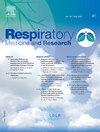抗合成酶综合征:关注间质性肺疾病作为诊断标准
IF 1.8
4区 医学
Q3 RESPIRATORY SYSTEM
引用次数: 0
摘要
抗合成酶综合征(ASyS)是一种自身免疫性疾病,临床表现通常包括间质性肺疾病(ILD)、肌炎和关节炎。虽然它与其他特发性炎症性肌病具有相同的特征,但ILD在该综合征中更为普遍且往往更为严重。本研究的目的是比较Connors和Solomon对ASyS的诊断标准,并研究除了ILD和相关抗体外,是否存在无附加症状、一种附加症状、或两种或两种以上症状表明预后较差。方法本回顾性单中心研究检查了先前根据Connors或Solomon标准诊断为ASyS的患者,并使用第273届ENMC国际研讨会标准和事后标准进一步分类。然后根据患者除了ILD和抗体外还有多少“定义性”体征和症状对患者进行分层。评估人口统计学特征、肺功能检查(PFT)、胸部CT以及临床结果。结果采用Solomons和Connors诊断标准的患者在人口学因素和PFT方面没有差异。在ILD和抗体组、附加1个标准组和附加2+标准组之间,在人口统计学、PFT和胸部CT上没有差异,尽管附加2个或更多标准的患者自诊断以来持续时间更长。本研究的主要发现表明,当使用不同的诊断标准诊断ASyS时,在诊断结果、治疗干预或死亡率方面没有差异。本研究建议重新评估ASyS的诊断标准,优先考虑ILD和相关抗体,而不是关注额外的标准,支持第273届ENMC国际研讨会(2024)的新ASyS定义标准。本文章由计算机程序翻译,如有差异,请以英文原文为准。
Anti-synthetase syndrome: A focus on interstitial lung disease as a diagnostic criteria
Background
Anti-synthetase syndrome (ASyS) is an autoimmune disorder with clinical manifestations that often include interstitial lung disease (ILD), myositis, and arthritis. Although it shares features with other idiopathic inflammatory myopathies, ILD is more prevalent and often more severe in this syndrome. The aim of this study was to compare Connors and Solomon diagnostic criteria for ASyS and investigated whether the presence of no additional symptoms, one additional symptom, or two or more symptoms, in addition to ILD and relevant antibodies, would indicate a worse prognosis.
Methods
This retrospective single-center study examined patients who were previously diagnosed with ASyS based on Connors or Solomon criteria and were further categorized using the 273rd ENMC International workshop criteria and post-hoc. The patients were then stratified based upon how many “defining” signs and symptoms that they had in addition to ILD and antibodies. Demographic characteristics, pulmonary function tests (PFT), chest CT’s—along with clinical outcomes were assessed.
Results
No differences in demographic factors and PFT’s were found between those who were diagnosed using Solomons versus Connors criteria. No differences in demographic, PFT’s and chest CT’s between those with ILD and antibodies only, with 1 additional criteria, and with 2+ additional criteria groups, although those with two or more additional criteria had a longer duration since diagnosis.
Discussion
Key findings from the study suggest that there are no differences in diagnostic outcomes, therapeutic interventions, or mortality rates when using different criteria to diagnose ASyS. This study suggests a reevaluation of diagnostic criteria for ASyS to prioritize ILD and relevant antibodies rather than a focus of additional criteria, supporting the new ASyS defining criteria from 273rd ENMC International Workshop (2024).
求助全文
通过发布文献求助,成功后即可免费获取论文全文。
去求助
来源期刊

Respiratory Medicine and Research
RESPIRATORY SYSTEM-
CiteScore
2.70
自引率
0.00%
发文量
82
审稿时长
50 days
 求助内容:
求助内容: 应助结果提醒方式:
应助结果提醒方式:


